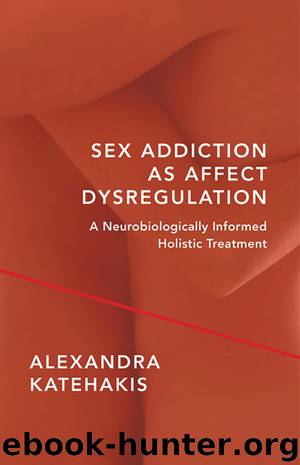Sex Addiction as Affect Dysregulation: A Neurobiologically Informed Holistic Treatment (Norton Series on Interpersonal Neurobiology) by Katehakis Alexandra

Author:Katehakis, Alexandra
Language: eng
Format: epub
Publisher: amazon
The long haul of psychoeducation and task work
A study in the mid 1980s analyzed the first 5 years of the recovery process for SAs and their partners, inventorying details month by month (Black, Kehrberg, Flumerfelt, & Schlosser, 1997, in Carnes, 2000; 1998). In the first year, most SAs reported feeling better despite experiencing chaos, challenges, and slips; some found symptoms actually worsening; and these responses yielded no quantifiable results. Yet the second and third years produced measurable improvements in friendships, self-image, career, finances, spirituality, and coping with stress—probably the benefits of engagement in intense therapeutic and 12-step work. Once personal recovery had been established, comments about the third, fourth, and fifth years showed significant healing in familial relationships: Romantic partnerships and relationships with parents, children, and siblings were said to have improved remarkably, and while some marriages proved irreparable, overall sexual and life satisfaction were judged as high (Carnes, 2000; 1998).
The study discerned six stages of recovery. The first, Developing Stage (up to 2 years), sees addicts reduce or replace some damaging behaviors. Minimization, a premier defense, may still operate even in the face of a growing recognition of the problem. Interestingly, at this phase, many therapists also seem to fail to confront or appreciate the gravity of SA.
The second, Crisis/Decision Stage, may last for a single day or up to 3 months, galvanized by a personal catastrophe (being caught by a spouse, or arrested, or fired; contracting an STI or being terminated by a therapist for noncompliance) or by a spontaneous recognition of their life’s unmanageability. After the addict genuinely decides to change, the third, Shock Stage may continue from 6 to 8 months. Rather like mourning, shock engenders reactions of denial, anger, depression, bargaining, and loneliness. In addition, many suffer intense withdrawal symptoms of disorientation, numbness, and despair. In fact, obeying limits set by therapists, family members, or a sponsor can elicit these feelings until the addict at last begins to experience a supportive sense of community. The 12-step adages, “One day at a time” and “Easy does it,” speak directly to this phase of recovery just before the addict appreciates actual relief.
Yet around 6 months into recovery, the Grief Stage appears. Once the impact of the initial discovery, decision to change, and shock begins to wane, the underlying emotional pain of this fourth stage sears. The person in recovery suddenly recognizes a new loss: He or she had already acknowledged forfeiting a primary relationship, connections with family members, job, time, money, or self-esteem. But this second one is the loss of the addiction itself. For many, that behavior provided the only stable, reliable succor. Saying goodbye to it can feel like parting from an old, ever-understanding friend and can evoke tremendous sorrow. In addition, forsaking the autoregulating actions exposes the deeper pain of early relational trauma. Without this comforting behavioral bandage, horrendous childhood memories the addiction served to cover lie raw. That agony helps explain the high relapse rates this stage of recovery invites (Carnes, 2000; 1998).
For those who persist, the fifth, or Repair Stage occurs between 18 and 36 months.
Download
This site does not store any files on its server. We only index and link to content provided by other sites. Please contact the content providers to delete copyright contents if any and email us, we'll remove relevant links or contents immediately.
| Adult Children of Alcoholics | Alcoholism |
| Drug Dependency | Gambling |
| Hoarding | Obsessive Compulsive Disorder (OCD) |
| Sexual | Smoking |
| Substance Abuse | Twelve-Step Programs |
The Hacking of the American Mind by Robert H. Lustig(4318)
Right Here, Right Now by Georgia Beers(4124)
Fingerprints of the Gods by Graham Hancock(3942)
Goodbye Paradise(3728)
Bad Pharma by Ben Goldacre(3357)
Happiness by Matthieu Ricard(2992)
More Language of Letting Go: 366 New Daily Meditations by Melody Beattie(2968)
The Social Psychology of Inequality by Unknown(2940)
The Plant Paradox by Dr. Steven R. Gundry M.D(2547)
Drugs Unlimited by Mike Power(2545)
Confessions of a Shopaholic by Sophie Kinsella(2278)
Borders by unknow(2229)
Make Love Not Porn by Cindy Gallop(2059)
Dry by Augusten Burroughs(2048)
Stop Being Mean to Yourself: A Story About Finding the True Meaning of Self-Love by Melody Beattie(1945)
Getting Off by Erica Garza(1892)
Belonging by Unknown(1806)
Yoga and the Twelve-Step Path by Kyczy Hawk(1786)
Unmasking Male Depression by Archibald D. Hart(1764)
